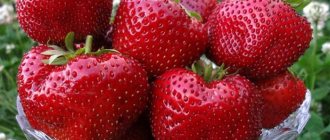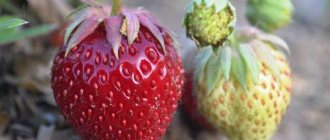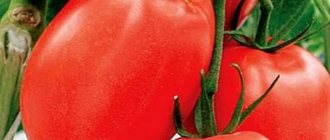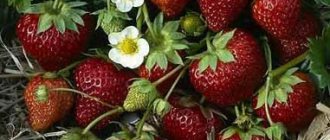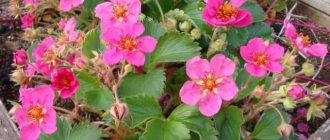After reading the description of the Garland strawberry variety, any gardener will quickly decide on the choice of crop. Bushes of these berries are found in any area. Breeders do a lot of work every year and develop new varieties of strawberries.
A well-known breeder from Russia, Galina Fedorovna Govorova, developed a magnificent variety of strawberries, “Garland”. It is frost-resistant. Strawberry fruits of the “Garland” variety appear before the first frost. As long as the sun shines brightly outside, the strawberry variety continues to bloom and bear fruit.
Features of the variety
The strawberry bush “Garland” is presented in the form of a ball. They are small. They reach only 20-25 cm in height. There is not much foliage on the bushes. The leaves are small and oval in shape. There are small teeth along the edges. The color of the leaves of “Garland” is rich green. A soft blue or bluish tint may be visible.
The antennae are also green. You can notice a pinkish tint on them. The most important positive aspect of the “Garland” variety of strawberries is its moderate growth.
An equally important factor is the fact that “Garland” bears fruit for more than six months from May to November. All this time, flower stalks can be observed on the bush of the variety, turning into wonderful, juicy and fragrant fruits.
Important! In order for the bushes to bear fruit as best as possible, carefully follow all the rules of agricultural technology. The main thing in this matter is feeding. It must be carried out in a timely manner. Having this type of fruiting, the plant needs a lot of nutrients.
The breeder who developed the “Garland” variety rightfully calls the bush “climbing.” After only 2 weeks from the moment of planting, the first tendrils form on it, on which rosettes will soon form. It is on the rosettes of strawberries that many flower stalks appear. Thanks to this, the strawberry variety is easily grown as an ornamental plant.
Selecting soil for planting
The berry can grow in almost any type of soil. Preference is given to chernozems and ash soils, while high peat content should be avoided. On the eve of planting the berry crop, it is necessary to harrow the soil to a depth of 15 cm.
It is advisable to choose a plot of land that is located away from a forest belt or planting, as this increases the risk of plant destruction by pests. If there are perennial weeds on the site, they should be eradicated before planting strawberries.
Description of the variety
“Garland” bushes have flowers of two sexes at once, which is very important at the time of pollination. Thanks to this, the berries of the Garland are formed on time.
The berries of the plant are presented in the shape of a cone. They have a rich bright red color. The fruits are not small. The average weight of one berry can reach 32g. The strawberry pulp has a delicate pink tint. The strawberry variety is very fragrant. After numerous checks, it became known that the taste characteristics of the berry received a score of 4.1 points.
If you properly care for the plants and carry out timely fertilizing, in just one season you can collect more than half a ton of berries from a plot of 1 hectare. From one bush the gardener will receive from 1 to 1.2 kg of juicy fruits. The garland copes well with transportation. Therefore, it retains its amazing appearance over a long period of time, and its taste characteristics remain unchanged.
The garland has good resistance not only to frost, but also to drought. If the soil is very wet, the plant will not like it.
Advantages and disadvantages
The advantages of Garland strawberries include:
- Growing does not take much time or excessive effort.
- Correct placement of antennae.
- Long and abundant fruiting.
- You can reap a good harvest from one bush.
- It copes well with transportation, after which it leaves its presentation.
And the biggest disadvantage of the Garland variety is its intolerance to strong moisture. Because of this, the plant can suffer many fungal diseases.
How to reproduce?
Strawberries of the Garland variety can be propagated in three ways:
- antennae;
- by dividing the bushes;
- using seeds.
Each method is good. But gardeners need to be as attentive and careful as possible so that the plant produces an abundant amount of fruit. To do this, you need to know at what time and how exactly you need to use each Garland propagation option.
Reproduction by tendrils or dividing the bush
If you decide to propagate the plant by tendrils or by dividing the bush, then spring and the end of August are good for this. Both methods of growing the Garland bush are more common and enjoy great success. The bushes begin to bear fruit as soon as the rosettes take root.
Propagation by seeds
If you decide to propagate the shrub using seeds, you must be patient and be prepared that this will take a lot of time. In order for planting to give the desired result, you should adhere to the following recommendations of experienced gardeners:
- Initially, you should properly prepare the containers intended for planting strawberries. You need to pour a small drainage layer on the bottom, and then fill the soil container to 3⁄4.
- After this, the soil should be moistened using a spray bottle. Then, the seeds are spread over the entire surface.
- Next, the container is sent to a dark and fairly cool place, where it spends 4-6 weeks.
- After this period of time, the containers with seeds must be taken out and covered with a small layer of earth on top. Then spray lightly with room temperature water. In order for the seeds to begin to germinate, they must then be placed in a warm place. It is important that the room is well ventilated.
- Maintain the correct temperature. The temperature should not be lower than 18 and higher than 22 degrees. Plantings require watering two to three times a week.
When the seedlings grow up, you can start planting them in other containers or in open ground.
How to make the right choice?
Do you want to get a bountiful, high-quality harvest? Then you need to choose the right material for planting. Before giving your preference to the Garland strawberry variety, you need to consider some points:
- “Garland” will grow only in loose soil. Soil fertility is no less important. It is important that it can allow moisture to pass through;
- Pre-sort the bushes carefully;
- seedlings must have rosettes and at least 3 leaves;
- as for the root system, it must be well developed and correctly formed;
- Each seedling must be healthy and have an attractive blooming appearance.
If the planting material does not have a good root system or has a sickly appearance, then the plant will be sick for a long time at the initial stage of development. Of course, there is no point in expecting a bountiful harvest from such bushes.
How to choose strawberry seedlings when purchasing
It is best to buy garden strawberry seedlings from trusted nurseries that have many positive reviews and provide a guarantee for their product. You can purchase seedlings at different times of the year. If the purchase is made at the beginning of summer, then in August you can get the first harvest. Autumn purchase and planting is rarely done, since then the strawberry bushes will begin to bear fruit only after a year. It is best to buy Garland seedlings in early spring. In this case, you can get the first harvest by the beginning of the first month of summer.
Did you know? The largest strawberry in history weighed 231 g. It was plucked from a bush in Kent, USA, in 1983.
Garden strawberries are not resistant to various diseases. This should be taken into account when choosing seedlings, since some seedlings may already be infected, for example, with powdery mildew
When purchasing, it is necessary to evaluate the health of seedlings and pay attention to the following nuances:
- Spotting on the leaves indicates the presence of a fungal disease. It is better not to buy such seedlings in the spring, but at the end of summer, small small spots on the leaves are quite acceptable.
- Do not buy seedlings whose leaves are wrinkled. This indicates that the plants are damaged by a microscopic strawberry mite.
- It is strictly forbidden to buy seedlings with pale leaves. This symptom most likely indicates a dangerous disease - late blight necrosis.
VIDEO: HOW TO CHOOSE THE CORRECT STRAWBERRY SEEDLINGS
Below we present a number of signs that correspond to high-quality healthy strawberry seedlings:
- The leaves are green, heavily pubescent, without spotting or damage.
- The horn must be thick (at least 7 mm). The thicker the horn, the higher the productivity of the strawberry bush.
- The root system of seedlings in cups or cassettes should completely fill the soil volume.
- At least 3 leaves must be formed on the rosette.
- The roots must be healthy and free from damage and rot. Rot indicates the presence of a fungal disease.
READ ALSO: Compote Homemade Fanta
Preparing the soil and site
Properly prepared soil before planting Garlands is the key to a good and abundant harvest. Therefore, you need to approach this issue with all responsibility.
When growing Garland, it is important to know that the plant grows well in almost any soil. The exception is soils with a high peat content. They do not tolerate loamy soil very well.
The place for these bushes should be open. Equally important is a sufficient amount of light. Try to avoid planting in places where there is groundwater. Places where rain and melt water accumulate are also not good.
If you have decided on a site for the Garland, then proceed to carefully processing and preparing it. Dig it up in advance to a depth of at least 25 cm, and before that add to the soil:
- In case of strong acidification - wood ash. For 1 sq.m. 0.5 buckets of raw materials.
- If the ground is heavy - sand. 3-4 kg per sq.m.
- For meager - 5-7 kg of humus per 1 sq.m. You can also use humus.
After digging the area, leave it to rest for a couple of weeks to allow the soil to settle. To grow Garland strawberries, the beds need to be raised a little. If you raise them only 30-40 cm, the bushes will give their owner juicy and large fruits.
Preparatory work before planting
To guarantee a good harvest, preparatory work should be carried out before planting:
- If the groundwater is high, the height of the beds should be raised to 40 cm. In this case, the distance between the bushes should be less than 30 cm.
- Before planting, it is recommended to dig the soil to the depth of one spade bayonet. When digging, fertilizers are added - compost or humus.
- The top layer of soil can be sprinkled with sawdust to prevent rotting of the berries placed on the ground.
Strawberry Garland, the cultivation of which does not require special skills, will delight gardeners with large berries and a rich taste if pre-planting work is carried out correctly.
Planting and which season is more favorable
In the central regions of the country, planting strawberry varieties must begin in mid-spring. If you live in the southern regions, then planting begins at the end of March. In the northern regions, it is not recommended to plant Garlands before mid-May.
If planting is planned in the fall, then use the time from late August to mid-September. This is the most favorable time, as the Garland bushes will have enough time to take root well. No less important is the time of planting. It is best to do this early in the morning or from five o'clock in the evening. In order for the Garland to take root well, it is best to choose a non-hot time. In this situation, the gardener will not need to shade the planting areas. As for the distance between strawberry bushes, keep a distance of 30 cm on each side.
The holes for planting garlands should be wide and free. This is necessary for the free placement of the roots of the bush. At the bottom of the hole you need to make a small mound along which the roots will spread. Existing voids are filled with earth. At the very base of the strawberries, the soil should be slightly compacted.
Newly planted plants should be watered well with warm water. After planting, you need to provide shade to the plants for several days. Especially if the weather is hot and sunny outside. When growing a Garland, even a novice gardener will not have much difficulty in preparing everything correctly and carefully. All you need is desire.
Reviews from gardeners
The description of the variety is completely true, which makes it worthy for growing in garden beds. High productivity and sufficient disease resistance are confirmed by reviews of summer residents who grow this crop on the site.
Terentyeva Galina Afanasyevna, Pskov:
My acquaintance with this variety began 3 years ago. I took a few mustaches from my neighbor in the garden and rooted them in the fall. In the spring, this plantation instantly grew and produced a significant harvest in the first year of its life. I'm happy with everything, I'm not going to take it out.
Mikhailov Alexander, Kirov:
I love this variety for its high storage capacity. I can keep the berries in the refrigerator for a week in the vegetable drawer, and they do not lose their properties. The second thing is the taste, it is unique. And what a aroma - words cannot describe.
Timofeev Stepan, Ivanovo:
Further care
Strawberries of the Garland variety, as it became known from the previous story, are an unpretentious plant. Further care of the crop will not take much time and effort. To do this, you just need to carefully follow the basic rules:
- water the plants in a timely manner;
- make regular feedings;
- loosen the soil;
- as a preventative measure, cultivate the land against possible diseases;
- Weed the beds regularly.
Garland bushes need to be watered infrequently. It does not require abundant watering. Here, the main thing is not to overdo it, as you can only harm the culture.
As for feeding, you need to be as careful as possible in this matter. Humus and humus are organic fertilizers. They only need to be used once a month. If we talk about herbal infusions and liquid mullein, then such fertilizers are used twice a month.
Use mineral fertilizers three times a month. Until the first flower stalks begin to appear on the bushes, the bushes should be treated with solutions containing nitrogen. When the plant begins to bear fruit, fertilizing is done with solutions, the main components of which should be potassium and phosphorus.
To ensure that the root system is saturated with a sufficient amount of air, the soil must be loosened regularly.
To prevent insects from attacking plants, it is recommended to weed the beds frequently. Thanks to this, you will protect your Garland strawberries from fungal diseases. In addition, the yield of the variety will increase.
Treatment against diseases and pests
Subject to compliance with agrotechnical rules, treatment of strawberries against pests and diseases is not required. Sometimes snails appear on the bushes. To prevent their appearance, stinging nettles are laid out around the perimeter and salt or red pepper is scattered. To repel harmful insects, you can plant garlic or marigolds nearby.
Where are strawberries of this variety used?
As mentioned above, the fruits of the Garland variety of strawberries are very juicy and attract with their wonderful smell and beautiful appearance. Looking at this variety of strawberries, you want to eat them right away.
There are many options where you can use the Garland strawberry variety. It is well suited for jam, and you can use it to make:
- All kinds of drinks: juices, uzvar and much more.
- Yoghurts prepared with strawberry varieties are very appetizing. Also prepare milk drinks using the Garland.
- It makes a very tasty confiture.
- Dumplings with strawberries Garland will conquer everyone.
The strawberry variety can be easily frozen in any form, even finely chopped. For the winter, the Garland can also be prepared by drying the berries.
Pros and cons of Strawberry Garland
The Garland variety of strawberries has many advantages, but there are also negative features.
| pros | Minuses |
| High yield | Poor drought tolerance |
| Long fruiting period | Low resistance to powdery mildew |
| Average resistance to drought and frost | With high humidity, fungal infections often occur. |
| Powerful immunity | |
| Pollen and fruiting do not depend on daylight hours | |
| Low maintenance | |
| The berries survive transportation safely |
See also
Description and characteristics of the Tago strawberry variety, cultivation technologyRead
Interesting Facts
Strawberries are the only berries that have seeds on the outside. One berry can contain about 200 seeds.
No less interesting is that Garland can be grown vertically by planting it in a flowerpot. This way it will not only bear fruit, but will also delight your eye as a decoration.
If you want to increase the yield of a plant, then experienced gardeners recommend removing the first 2 flower stalks from the bush. While the Garland bears fruit, all the berries are the same size.
Important! There is no need to place the root rosette completely in the soil. This may cause the plant to die.
Reproduction
Propagated using tendrils or seedlings that are grown from seeds. To root the mustache, select shoots that have a root collar with a diameter of at least 6 mm. The root shoots of seedlings should be 7-9 cm long.
When seeds are used to propagate strawberries, they are subjected to stratification. To do this, the seeds are mixed with wet sand, wrapped in nylon cloth and placed in the refrigerator. The seed exposure time at low temperatures is 2 months. The best time to plant seeds is March.
Planting material along with sand is evenly distributed over the surface of well-loosened fertile soil, poured into seedling boxes. After sowing, the soil is slightly compacted and moistened. To preserve heat, boxes are covered with glass or transparent film. It is much easier to propagate with a mustache. It is enough to root them in the ground and transplant them to a new bed for the winter.



